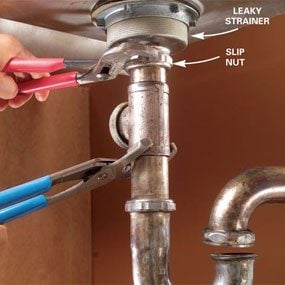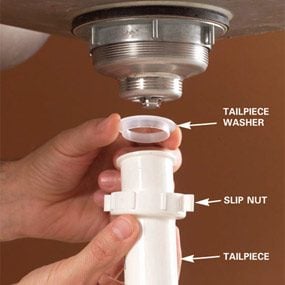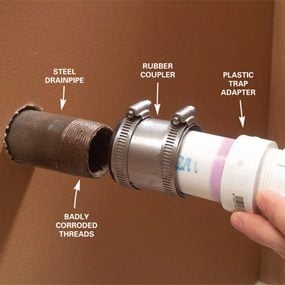Home Rooms Kitchen Kitchen Drains
Updated: Jun. 14, 2023
Remove a leaky chrome kitchen waste line and replace it with a plastic PVC waste line and trap.
Next Project›

It's time to get rid of that drip-catching bucket under your kitchen sink. Whether your pipes need total replacement or just tightening, here's how to put an end to the leaks. We'll show you how to find the leak, then fix it for good.
By the DIY experts of The Family Handyman Magazine
- Time
- Complexity
- Cost
- A full day
- Intermediate
- Less than $20
How to Install Kitchen Sink PlumbingStep 1: Straighten kitchen sink plumbing pipes and tighten nuts
The washers that seal pipe joints won’t hold water unless one section runs straight into the other. The “ground” joint on the trap has no washer, but it too will leak if it’s misaligned. Eyeball the leaking joint to check its alignment. If it’s crooked, simply loosen the nut, straighten the pipe and retighten. Since the whole assembly is interconnected, you might misalign one joint while straightening another. Don’t be surprised if you end up loosening and tightening several joints to straighten just one.
If a joint is aligned but leaks anyway, tighten the slip nut. Use two slip-joint pliers on metal pipes: one to hold the pipe, the other to tighten the nut. If you have old metal pipe, you might find that it has worn thin and collapses when you put a pliers on it. With plastic pipe, hand-tighten first. If that doesn’t stop the leak, use a pliers. But be gentle; plastic threads are easy to strip.
Finding a Leak in Under Sink Pipes
Before you can stop a leak in your kitchen sink plumbing, you have to find its source. That can be tricky. Water that escapes your pipes can travel a long way before it drops onto your cabinet’s floor.
Here’s how a drip detective tracks the source of a leak: Fill both bowls of the sink with lukewarm water, not cold. (Cold water can cause beads of condensation to form on the pipes, making it impossible to find the leak.) Then get under the sink with a trouble light. Dry off all the pipes and examine the seals around the basket strainers. If you don’t see any droplets forming, remove both sink stoppers and watch for telltale dribbles.
Joints are the most likely source of leaks, but old metal pipes can develop pinhole leaks anywhere, especially in the trap. If you can’t find any leaks in the drain system, check the water supply lines that serve the faucet. Finally, check for “splash leaks,” spots where water seeps under the sink rim or faucet base. To find these leaks, use a rag to dribble water around the faucet and sink rim, then get underneath and look for drips.
How to Install Kitchen Sink PlumbingStep 2: Reseal a leaky strainer
How to Install Sink Drain Pipe Photo 1: Take the drain apart
Disassemble the kitchen sink drain assembly so you can remove the leaky strainer. Turn slip nuts counterclockwise, using a second set of pliers if necessary to keep the pipes from turning.
How to Install Sink Drain Pipe Photo 2: Take out the strainer
Turn the locknut counterclockwise to remove the strainer. Have a helper stick the handles of pliers into the strainer holes and keep the strainer from turning using a screwdriver.
How to Install Sink Drain Pipe Photo 3: Cut the locknut if it won’t unscrew
Cut the locknut with a hacksaw if you can’t unscrew it. Cut at a sharp diagonal angle and be careful not to cut into the sink.
The primary seal around a basket strainer is plumber’s putty, which doesn’t last forever. Over the years it can harden, shrink or crack. Sometimes you can stop a leak by tightening the locknut. But in many cases, the only cure is a new dose of putty.
Photos 1-4 on show you how. You can reuse the old strainer if all the parts are in good shape, but it usually makes sense to replace it. Since you have to take apart most of the drain assembly to get at a leaking strainer (Photo 1), consider replacing the kitchen sink plumbing drain lines if they’re old.
The hardest part of this job is unscrewing the old locknut, which is often welded in place by mineral deposits or corrosion. A special wrench designed just for locknuts, called a “spud wrench” or “locknut wrench“ (Photo 2). Big slip-joint pliers with a 3-1/2 in. jaw opening will work too, plus you can use them for other jobs. Whatever tool you use, you might find that the locknut won’t budge. In that case, a single cut with a hacksaw blade is the only solution (Photo 3). It’s almost impossible to do this without cutting into the strainer threads, so plan on buying a new strainer.
Figure A: Basket Strainer Assembly
This photo shows the washers and locknut that connect the basket
How to Install Kitchen Sink PlumbingStep 3: If the kitchen sink plumbing pipes are old, replace the whole works
How to Install Sink Drain Pipe Photo 1: Connect the tailpiece to the strainer
Attach the tailpiece to the basket strainer, but don’t fully tighten it yet; you’ll have to remove and cut it later.
How to Install Sink Drain Pipe Photo 2: Place the trap arm under the tailpiece
Slide the trap arm into the adapter. Then attach the trap and slide the arm in or out to position the trap directly under the tailpiece. You may need to cut the arm or add an extender.
How to Install Sink Drain Pipe Photo 3: Mark and cut the tailpieces to size
Hold the waste tee alongside the tailpiece about 1-1/2 in. below the top of the trap. Mark the tailpiece 1/2 in. below the top of the tee. Cut both tailpieces to the same length and install them.
How to Install Sink Drain Pipe Photo 4: Mark and cut the waste arm
Slip the waste arm onto the second tailpiece, make it extend about 3/4 in. into the tee and mark it. Cut and install it.
Some kitchen sink plumbing leaks can’t be stopped with straightening or tightening. Stripped nuts won’t tighten and old washers won’t seal because they’re stiff and distorted. You could get new nuts, washers or drain parts. Since plastic pipe is so inexpensive and easy to install, the smart, reliable fix is a whole new drain assembly.
You can buy everything you need at home center. Kits for side outlet assemblies (like the one shown here) or center outlet assemblies (where the trap is beneath the center of the sink) contain most of the essential parts. But you might also need:
- Long tailpieces (Photo 1). The tailpieces that come with kits are often only a couple of inches long.
- A trap arm extender (Photo 2). The arm that comes with the kit may not reach the drainpipe that protrudes from the wall.
- A dishwasher wye that has a connection for your dishwasher hose.
- A disposer kit that allows the waste arm to connect to a garbage disposer. Photos 1-5 detail the whole replacement process.
Here are some pointers for a smooth project:
- You’ll have to cut a few pipes: both tailpieces, the waste arm and maybe the trap arm. A fine-tooth hacksaw works best.
When in doubt, mark and cut pipes a bit long. Better to cut twice than cut too short and make an extra trip to the hardware store.
- Don’t forget to insert tailpiece washers (Photo 1). Other joints require cone washers. The only joint without a washer is the ground joint at the trap.
- Assemble everything loosely until the whole assembly is complete. Then tighten all the slip nuts.
- Hand-tighten the slip nuts. If any joints leak when you test the new assembly, tighten them slightly with slip-joint pliers.
- When you’re all done, test the assembly for leaks.
Figure B: Replace the Whole Assembly
This photo shows the parts needed to connect the strainer to the waste arm. For a larger image that also shows the trap and trap arm, see the Addendum.
Tip:
Brush a little Teflon pipe thread sealant on male threads. It lubricates the threads and makes slip nuts much easier to tighten. Check the label to make sure the sealant is safe for plastic.
How to Install Kitchen Sink Plumbing Step 4: Install a new adapter on old steel pipe
The drainpipe coming out of the wall has an adapter on the end. This adapter has a washer and slip nut and works just like the other joints in your drain assembly. If your drainpipe is plastic, you shouldn’t have any problems. But if your drainpipe is old galvanized steel, you might run into corrosion that makes the slip nut almost impossible to loosen or retighten.
Here’s how to bypass those rusty old threads: Unscrew the old slip nut. Cut it off with a hacksaw if you have to, but try not to cut deep into the drainpipe’s threads. Buy a plastic trap adapter, a rubber transition coupler, a section of plastic pipe and cement. The pipe and adapter can be PVC (white) or ABS (black); just be sure to get the right cement for the type of plastic (PVC also requires purple primer). Cement the adapter to a 4-in. piece of pipe and join the plastic pipe to the old metal pipe using the rubber coupler.
Additional Information for under sink pipes
Required Tools for this how to install kitchen sink plumbing project
Have the necessary tools for this DIY kitchen sink plumbing project lined up before you start—you’ll save time and frustration.
- 4-in-1 screwdriver
- Hacksaw
- Level
- Pliers
- Slip joint pliers
- Tape measure
Required Materials for this how to install kitchen sink plumbing project
Avoid last-minute shopping trips by having all your materials ready ahead of time. Here’s a list.
- Basket strainer
- Cardboard washer
- Locknut
- Plumber's putty
- Rubber washer
- Tailpiece
- Tailpiece washer
- Waste arm
You can buy everything you need for a new drain assembly in a kit at home centers for about $15.
Originally Published: May 20, 2019










